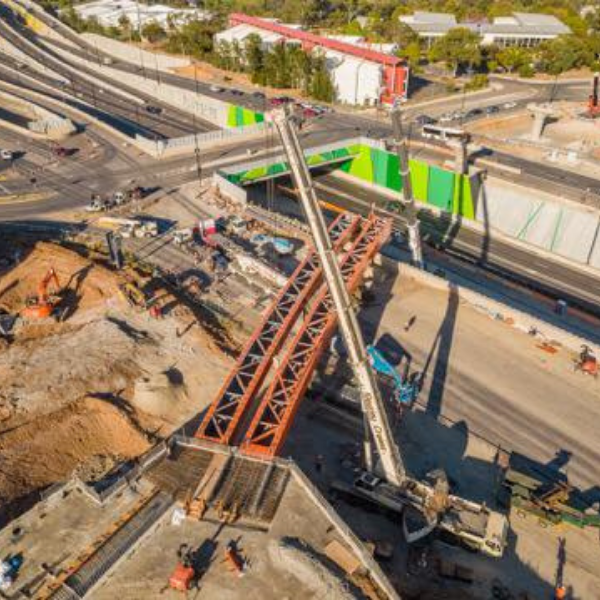
Key Information
- 140 tonnes of non-standard welded beams were supplied to fabricator Bowhill Engineering
- High-grade G400 steel is commonly used for long-span bridges and other applications where strength and structural integrity are key
- Bowhill Engineering employed precision fabrication and pre-cambering to the steel beams prior to delivery to the South Yarra site
A long-span bridge above the future entrance of the Metro Tunnel near Melbourne’s William Street has been constructed with the use of high-grade steel supplied by InfraBuild Steel Centre.

Structural steel supplied by InfraBuild Steel Centre has been used in the construction of a new bridge over the widened rail corridor near Melbourne’s South Yarra Station.
Approximately 140 tonnes of welded beams were supplied for the long-span William Street Bridge, which was installed above the future eastern entrance of the Metro Tunnel near William Street.
The project’s Rail Infrastructure Alliance, featuring major contractors John Holland and CPB, installed the bridge structure during a weekend rail occupation in November 2019.
The new bridge spans the rail corridor, is 57 metres long, 3.8 metres high and approximately 30 metres wide at its widest point.
The challenge: a long-span bridge built to last
The William Street Bridge needed to span several rail lines and featured difficult approach angles. This required that a number of non-standard lengths of welded beam be used. InfraBuild Steel Centre put steel plate on order that was then used to manufacture a mixture of 800 (80cm high) and 1000 (1m high) welded beams for fabricator Bowhill Engineering.

With the beams a mixture of different lengths and sections, project lead-time required special consideration, plus a large degree of collaboration between supplier InfraBuild Steel Centre and fabricator Bowhill Engineering was needed.
InfraBuild Steel Centre was tasked with manufacturing each welded beam to a bespoke length, with Bowhill Engineering needing to ensure precise fabrication of the spanning beams and cross-members to allow seamless construction of the bridge’s constituent parts on site.
The solution: bespoke beam lengths and precision fabrication
InfraBuild Steel Centre’s Gordon Smith says high-grade G400 steel was used to make the welded beams, which were supplied to Bowhill Engineering from Steel Centre’s Port Adelaide branch.
G400 steel is a low-tempurature steel that offers durability and strength, so it’s commonly found in the likes of bridge construction. For this bridge, the long lengths required were highly unusual and required considerable planning to meet Bowhill’s needs.
Gordon Smith, InfraBuild Steel Centre
Bowhill Engineering, which specialises in high-spec, large-component fabrication of steel for bridges, wharves and other critical structures, then fabricated and assembled the bridge at the company’s yard east of Adelaide.

“We pre-assembled the entire bridge to ensure everything would go smoothly on site,” said Bowhill Engineering Senior Project Manager Michael Harris.
The beams were longer than standard – to avoid a spliced weld, we had them custom-made lengthwise by InfraBuild. We did finer cuts to them once the drawings were approved, put end plates on and, on average, put two shear studs every 300 mm across the length of them.
Gordon Smith, InfraBuild Steel Centre
“We ordered the beams without a pre-camber, so we pre-cambered them after fabrication,” Gordon explains.
“The whole thing had to be super accurate. When you’re installing spanning beams and putting intermediate beams between them, you have to be spot-on for that to work. We had different angles on the stubs that were welded to the main beams and had to make sure the bolted splice flanges were accurate at the end of the beams.”
The outcome
The two spanning beams, weighing a combined 244 tonnes, were used to construct the bridge sides, with a 750-tonne crane and two smaller cranes used to position the spanning beams in place. The Rail Infrastructure Alliance project team installed these over the course of a weekend to minimise disruptions to rail traffic. With these spanning beams secured, the team then installed a series of intermediate steel supports, with pre-cast planks laid on top to form the bridge.
InfraBuild supplied a good product on time. They wored with the design team and procurement team earky on in the piece.
Michael Harris, Bowhill Engineering Senior Project Manager
Harris explains that the spanning beams made for an impressive sight. “They were 4m deep and some of the flange material was 100mm thick. Where you’ve got a splice you had 260mm of solid steel.
“It’s the most heavy-duty material I think we’ve ever used on a job from a plate perspective,” Harris said.
William Street Bridge Project Team
- Primary contractor: Rail Infrastructure Alliance (John Holland / CPB Contractors JV)
- Steel Supplier: InfraBuild Steel Centre
- Fabricator: Bowhill Engineering
Video courtesy Rail Projects Victoria
Related Case Studies
Subscribe to the
InfraBuild newsletter
Receive regular updates on news, case studies as well as the latest products and services.




